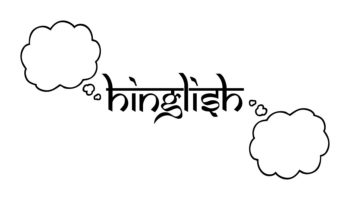Characteristics of Urban Hindi Posted by Nicole Herbert Dean on Apr 11, 2021 in Hindi Language
Characteristics of Urban Hindi
As we tackle the fast-paced evolution of languages all over the world due to the internet. We will take a look at the ever-evolving speech of the Hindi language in India.
In our last post, we discussed social media’s use of a mixture of Hindi and English in speech.
The combination संबंध of Hindi and English is very common सामान्य in India among the educated class. This code-switching is popular and has several characteristics लक्षण. Bollywood embraced it gladly and so have their audience.
15 Characteristics of Modern Urban Hindi
- Young, urban, mostly upper ऊपरी middle class speak this language. These speakers study at schools, colleges, and universities whose language of instruction is English. And therefore, they prefer पसंद करना to speak mostly English interspersed with Hindi.
- There is a cool factor associated with speaking Hindi with mostly English words.
- Certain Hindi words are quickly becoming extinct thanks to lack of use.
- The younger code switchers use उपयोग more English content in their speech, as compared तुलना to the older urban code switchers who use more Hindi in their speech.
- Older generations prefer to use more Hindi because क्योंकि older generations पीढ़ियों studied mostly in Hindi medium schools and then went फिर चला गया onto to English medium colleges and universities.
Rules governing the language
- There are no set rules कोई निर्धारित नियम नहीं for code-switching. Meaning, there are no particular विशेष words that are typically in English or typically in Hindi in a sentence.
- Code-switching occurs with words, whole phrases पूरे वाक्यांशों के साथ, and whole sentences.
- Speakers insert the mixture of Hindi and English between sentences and even in the middle of the sentence वाक्य.
- Young urban college students are embarrassed शर्मिंदा to use certain Hindi words such as teacher शिक्षक, train रेलगाड़ी, car गाड़ी as they sound old fashioned पुराने जमाने.
- Using the English version is easier and modern. For example, it is easier to say, ‘car’ than to say गाडी (pronounced gaa-dee, with the rolled hard dental ‘r’).
Who speaks this language
- People started increasing their use of English in Hindi sentences in the 1990s.
- People are increasingly exposed to English with the advent of the internet and mobile use due to the liberalization उदारीकरण of the economy.
- Millennials studying overseas and traveling all over the world pick up English words and phrases that are trendy.
- It is common to hear an older person एक वृद्ध व्यक्ति speaking full Hindi sentences while the younger person युवा व्यक्ति is participating in the conversation in half Hindi and half English. Conducting this conversation while using both languages is quite chic.
- People who live outside India have lost some words कुछ शब्द खो दिए हैं due to lack of use.
Bollywood and Hinglish
Bollywood is a major influencer of this trend. Actor Rajesh Khanna said the famous line, “Pushpa, I hate tears.” in the blockbuster, Amar Prem. Lately, actor Salman Khan told his female lady love, “दोस्ती का एक उसूल हैं (there is a principle in friendship), madam: no sorry, no thank you” in the movie, Maine Pyar Kiya.
There are websites devoted to quoting these lines from famous stars. Youngsters love to use these lines in everyday conversation displaying knowledge of not only the latest movies but also the latest trends in speaking English. The evolving trend is to speak a watered-down version of Hindi. One way to keep Hindi intact is to continue teaching it to future generations in its purest form.

Build vocabulary, practice pronunciation, and more with Transparent Language Online. Available anytime, anywhere, on any device.




